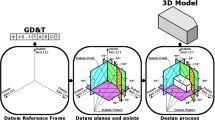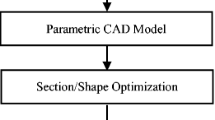Abstract
This paper considers the fitting of a CAD template model to tessellated data as strategy to implement a reverse engineering process that aims at the reconstruction of a parametric associative CAD model. The reconstruction methodology, called Template-Based CAD Reconstruction (TCRT), has been presented and fully discussed in a previous paper Buonamici et al. (J Comput Des Eng 5:145–159, 2018). The present paper focuses on the study of a fast and robust strategy to perform the fitting of the Template CAD Model to reference data. The study explores how different optimization strategies and evaluation metrics can affect a parametric CAD-fitting methodology. Two different optimization algorithms (PSO and GA) and three formulations of the objective function are tested to find the most effective combination. Reconstruction test cases are presented and discussed in the text.






















Similar content being viewed by others
Notes
This could happen for multiple reasons: some dimensions could be standard or derived from the function of the object.
The description of implementation details falls outside the scopes of this paper.
NF is estimated as the minimum error that is significant for the specific reconstruction.
Upper/Lower bounds are actually imposed for some parameters: all linear dimensions, for example, have zero as lower bound; for the upper bound, the main diagonal’s length of the Reference data’s bounding box is used as reference value. Angles, on the other hand, are bounded in a [0, 360]° interval. No particular bounds are imposed for the positional parameters. The TCRT automatically identifies each type of parameter and assigns its correct options.
A population of possible solutions is updated at each iteration according to the results obtained by the population at previous iterations. A fixed number of function evaluations is performed at each iteration.
Software: Microsoft operating system (i.e. Windows 7), Siemens NX 10 and MATLAB R2018a. Hardware: 128 GBs RAM workstation supplied with two six-core Intel® Xeon® E5-2643 v3 processors, each of which can manage up to 12 threads simultaneously at 3.40 GHz. All the tests have been executed using 22 simultaneous NX instances running in parallel.
GFE values that are under the goal line in Fig. 11 (\({f}_{3}\) metric) are caused by the post-processing of data (uniformization in corresponding \({f}_{1}\) values).
Gradient-based algorithms are not suited for the final refinement, due to the presence, even at this stage, of local minima. Pattern Search was chosen by the authors as it seemed fit to tackle this specific reconstruction problem.
Abbreviations
- TCRT:
-
Template-based CAD Reconstruction Tool
- GFE:
-
Global Fitting Error
- PSO:
-
Particle Swarm Optimization
- GA:
-
Genetic Algorithm
References
Buonamici F, Carfagni M, Furferi R, Governi L, Lapini A, Volpe Y (2018) Reverse engineering modeling methods and tools: a survey. Comput Aided Des Appl 15:443–464. https://doi.org/10.1080/16864360.2017.1397894
Anwer N, Mathieu L (2016) From reverse engineering to shape engineering in mechanical design. CIRP Ann - Manuf Technol 65:165–168. https://doi.org/10.1016/j.cirp.2016.04.052
Buonamici F, Carfagni M (2016) Reverse engineering of mechanical parts: a brief overview of existing approaches and possible new strategies. In: Proceedings of the ASME design engineering technical conference, 1B-2016. https://doi.org/10.1115/DETC2016-59242
Werghi N, Fisher R, Robertson C, Ashbrook A (1999) Object reconstruction by incorporating geometric constraints in reverse engineering. CAD Comput Aided Des 31:363–399. https://doi.org/10.1016/S0010-4485(99)00038-X
Kovács I, Várady T, Salvi P (2015) Applying geometric constraints for perfecting CAD models in reverse engineering. Graph Models 82:44–57. https://doi.org/10.1016/j.gmod.2015.06.002
Li Y, Wu X, Chrysathou Y, Sharf A, Cohen-Or D, Mitra NJ (2011) GlobFit: consistently fitting primitives by discovering global relations. ACM Trans Graph 30(52):1–12. https://doi.org/10.1145/2010324.1964947
Langbein FC, Marshall AD, Martin RR (2004) Choosing consistent constraints for beautification of reverse engineered geometric models. Comput Des 36:261–278. https://doi.org/10.1016/S0010-4485(03)00108-8
Beniere R, Subsol G, Gesquière G, Le Breton F, Puech W (2013) A comprehensive process of reverse engineering from 3D meshes to CAD models. CAD Comput Aided Des 45:1382–1393. https://doi.org/10.1016/j.cad.2013.06.004
Tsai Y-C, Huang C-Y, Lin K-Y, Lai J-Y, Ueng W-D (2009) Development of automatic surface reconstruction technique in reverse engineering. Int J Adv Manuf Technol 42:152–167. https://doi.org/10.1007/s00170-008-1586-2
Buonamici F, Carfagni M, Furferi R, Governi L, Lapini A, Volpe Y (2018) Reverse engineering of mechanical parts: a template-based approach. J Comput Des Eng 5:145–159. https://doi.org/10.1016/j.jcde.2017.11.009
3D scanning, design and reverse engineering software from 3D Systems Geomagic. https://www.geomagic.com/en/. Accessed 13 Jun 2017
Zehtaban L, Elazhary O, Roller D (2016) A framework for similarity recognition of CAD models. J Comput Des Eng 3:274–285. https://doi.org/10.1016/j.jcde.2016.04.002
Kennedy J, Eberhart R (1995) Particle swarm optimization. In: Proceedings of ICNN'95 - international conference on neural networks. IEEE, pp 1942–1948. https://doi.org/10.1109/ICNN.1995.488968
Genetic Algorithm—MATLAB and Simulink. https://it.mathworks.com/discovery/genetic-algorithm.html. Accessed 9 Jan 2019
Global Optimization Toolbox—MATLAB. https://it.mathworks.com/products/global-optimization.html. Accessed 19 Dec 2018
Find minimum of function using pattern search—MATLAB patternsearch—MathWorks Italia. https://it.mathworks.com/help/gads/patternsearch.html. Accessed 11 Jan 2019
Author information
Authors and Affiliations
Corresponding author
Additional information
Publisher's Note
Springer Nature remains neutral with regard to jurisdictional claims in published maps and institutional affiliations.
Rights and permissions
About this article
Cite this article
Buonamici, F., Carfagni, M., Furferi, R. et al. Reverse engineering by CAD template fitting: study of a fast and robust template-fitting strategy. Engineering with Computers 37, 2803–2821 (2021). https://doi.org/10.1007/s00366-020-00966-4
Received:
Accepted:
Published:
Issue Date:
DOI: https://doi.org/10.1007/s00366-020-00966-4




